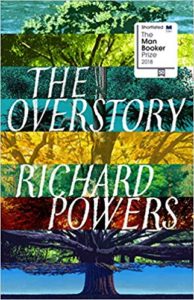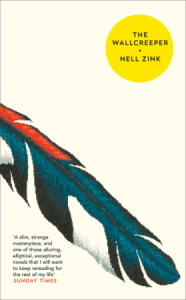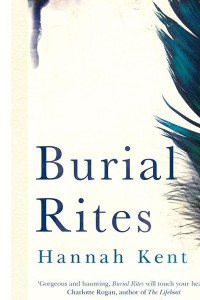“The Overstory” by Richard Powers
 They read about myrrh-tree transplanting expeditions depicted in the reliefs at Karnak, three thousand five hundred years ago. They read about trees that migrate. Trees that remember the past and predict the future. Trees that harmonize their fruiting and nutting into sprawling choruses. Trees that bomb the ground so only their own can grow. Trees that summon air forces of insects that come to save them. Trees with hollowed trunks wide enough to hold the population of small hamlets. Leaves with fur on the undersides. Thinned petioles that solve the wind. The rim of life around a pillar of dead history, each new coat as thick as the maker season is generous.
They read about myrrh-tree transplanting expeditions depicted in the reliefs at Karnak, three thousand five hundred years ago. They read about trees that migrate. Trees that remember the past and predict the future. Trees that harmonize their fruiting and nutting into sprawling choruses. Trees that bomb the ground so only their own can grow. Trees that summon air forces of insects that come to save them. Trees with hollowed trunks wide enough to hold the population of small hamlets. Leaves with fur on the undersides. Thinned petioles that solve the wind. The rim of life around a pillar of dead history, each new coat as thick as the maker season is generous.
Richard Powers The Overstory is a novel weaves through it stories of various families/individuals spanning more than a century. It is a fine example of eco-fiction that is preoccupied with discussing the perennial Man vs Nature argument. It is a vast novel not only for the subject it tackles but the vastness of the landscape Powers creates. It flits from an immigrant family to that of environmental activist to an Indian software entrepreneur who amasses a fortune by creating games to the most mesmerising character, dendrologist, Patricia Westerford. While all these lives are being described it is impossible not to draw comparisons with the peaceful and vibrant descriptions of Nature that Thoreau wrote about in the nineteenth century or even perhaps with the truly talented writer Nell Zink. But now we are at the brink of a possible ecological disaster, possibly manmade due to the wilful damage done upon the environment by man. The LitHub describes it perfectly as “Henry David Thoreau meet Georgia-Pacific“.
The genesis of this novel Powers describes in an interview to The Chicago Review of Books:
I was teaching at Stanford and living in Palo Alto, in the heart of Silicon Valley. Just to one side of me was one of the greatest concentrations of wealth and technological might in history: the corporate HQs of Google, Apple, Intel, HP, Facebook, eBay, Cisco, Tesla, Oracle, Netflix, and so many more. To the other side were the Santa Cruz mountains, covered in redwoods. When the scramble for the future down in the valley was too much for me, I would head up to walk in the woods. These were the forests that had been clear-cut to build San Francisco, and it seemed to me that they had grown back wonderfully. But one day, I came across a single tree that had, for whatever reason, escaped the loggers. It was the width of a house, the length of a football field, and as old as Jesus or Caesar. Compared to the trees that had so impressed me, it was like Jupiter is to the Earth.
I began to imagine what they must have looked like, those forests that would not return for centuries, if ever. It seemed to me that we had been at war for a long time, trees and people, and I wondered if it might be possible for things ever to go any other way. Within a few months, I quit my job at Stanford and devoted myself full time to writing The Overstory.
Yet the gloomy moments of the book are more than compensated for by the hope written on the last page of this stunningly magnificent book.
His friends begin to chant in a very old language. It strikes Nick as strange, how few languages he understands. One and a half human ones. Not a single word of all the other living, speaking things. But what these men chant Nick half grasps, and when the songs are finished, he adds, Amen, if only because it may be the single oldest word he knows. The older the word, the more likely it is to be both useful and true. In fact, he read once, … that the word tree and the word truth came from the same root.
The best compliment he could ever have received was from fellow novelist Barbara Kingsolver who reviewed his book for the New York Times. Upon reading her review he was ‘beside himself with gratitude to Kingsolver. “I just feel so lucky,” he says. “She makes a case for a broader way of reading me.” Taking issue with Powers’ reputation for cold, science-y novels, Kingsolver writes The Overstory “accomplishes what few living writers from either camp, art or science, could attempt. Using the tools of story, he pulls readers heart-first into a perspective so much longer-lived and more subtly developed than the human purview that we gain glimpses of a vast, primordial sensibility, while watching our own kind get whittled down to size.” ‘
The Overstory is a powerful testimony to the decades of environmental activism and the damage man can cause. Yet it is not a novel meant for all readers. It is not an easy book to read and requires intense engagement. Even Powers has had to admit that it was a life-changing experience for him writing The Overstory, akin to a “religious conversion“. Award-winning novelist Powers is known to combine his passion for philosophy with science. In his 12th novel he has done much the same opting to talk about the environment, a subject that is not only dear to his heart but extremely relevant now. No wonder it was shortlisted for the Man Booker Prize 2018.
To buy on Amazon India:
26 October 2018


